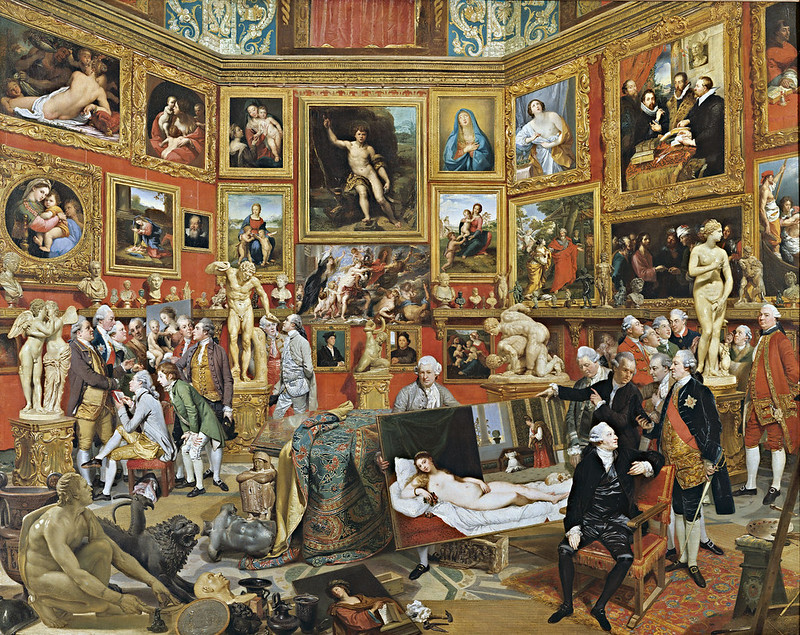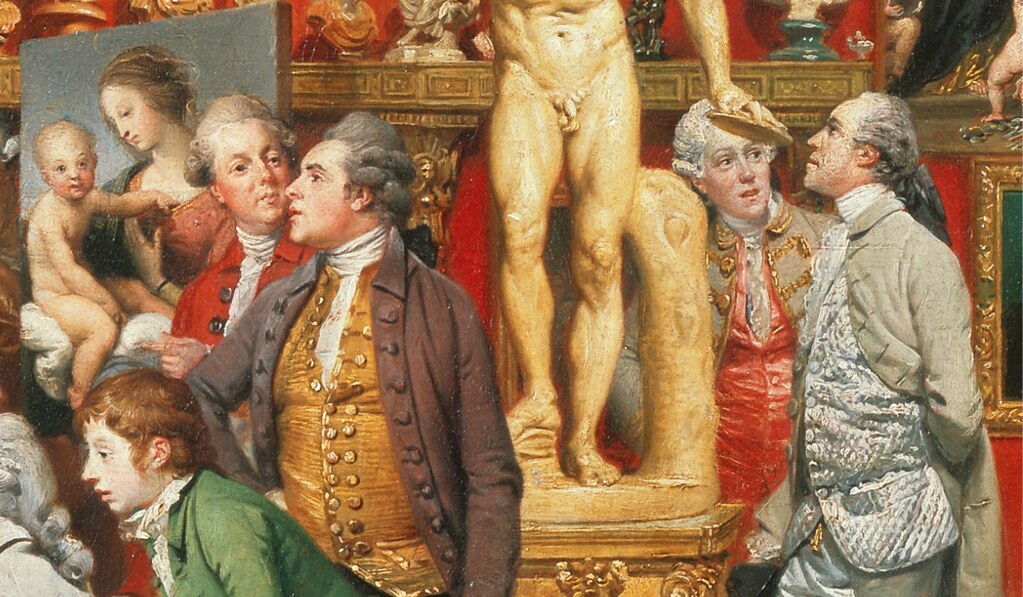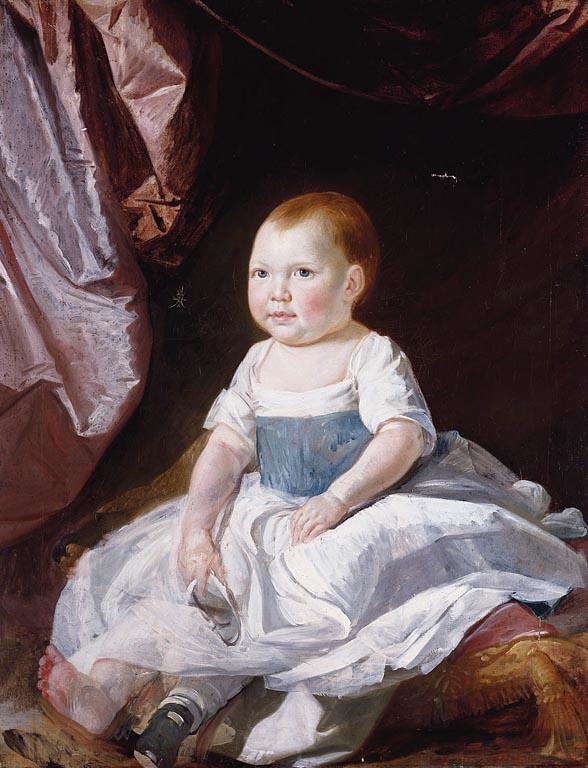В Уффици в XVIII веке
В музее - 4
В музее - 1. В музее - 2. В музее - 3

Иоганн Цоффани (1733-1810). Трибуна Уффици, 1772-1777 / Johan Joseph Zoffany (Frankfurt 1733-London 1810). The Tribuna of the Uffizi. 1772-1777. Oil on canvas. In an exhibition, The Queen's Gallery, Buckingham Palace. RCIN 406983. Royal Collection Trust /© Her Majesty Queen Elizabeth II 2016. Source. Original (5803 x 4606). Google Art
«Энциклопедический словарь Брокгауза и Ефрона», 1903 о художнике Иоганне Цоффани /Johan Joseph Zoffany (Frankfurt, 1733 - London, 1810):
" Цоффани (Иоганн-Георг Zoffani, 1733-1810) - немецкий живописец, настоящая фамилия которого была Цауффели, учился, будучи еще мальчиком, в Регенсбурге у Шпеера и образовался окончательно в Италии, где провел 11 лет. По возвращении своем оттуда в Регенсбург, женился, но неудачно, и, спасаясь от несчастной семейной жизни, уехал в Англию.
Здесь сперва не имел успеха, до тех пор, пока несколько написанных им портретов знаменитых актеров (Гаррика, Флута, Уэста и др.) не доставили ему известности. С.-Мартин-Ленская и Лондонская королевская академии избрали его в свои члены.
После того, по поручению Георга III и с его денежною поддержкою, он отправился вторично в Италию и написал во Флоренции, между прочим, вид трибуны тамошнего музея Уффици со всеми находящимися в ней картинами (теперь у английского короля) и, по заказу императрицы Марии-Терезии, портреты тосканской великогерцогской фамилии. Явившись в 1778 г. по приглашению названной государыни в Вену, пользовался ее благорасположением и был в почете у тамошней аристократии.
2.

Трибуна Уффици, фрагмент. 1772-1777. Иоганн Цоффани (1733-1810). Британская королевская коллекция. Google Art
В 1783 г. предпринял путешествие в Индию и, пробыв там до 1790 г., успел составить тебе там большое состояние и вернулся в Лондон, где продолжал трудиться до самой своей смерти, но уже с меньшим мастерством, чем прежде. Отличаясь в лучшую пору своей деятельности верностью при передаче натуры, приятностью красок и ловкостью кисти, Цоффани был особенно силен в портретах, хотя охотно писал и другие сюжеты.
3.

Трибуна Уффици, фрагмент. 1772-1777. Иоганн Цоффани (1733-1810). Британская королевская коллекция. Google Art
Наиболее известные из его произведений - портреты эрц-герцогини Марии-Христины (в Венском музее), Гаррика (в Лондонской национальной галерее), собственный портрет (в Лондонской портретной галерее), Фердинанда Бурбонского (в Пармской пинакотеке), «Собрание членов Лондонской королевской академии» (у лорда Мордоунта), «Петушиный бой в Индии» (гравирован Ирломом), «Охота на тигров» (то же) и «Посольство Гайдер-Бека» (то же). "
Цоффани, Иоганн-Георг // Энциклопедический словарь Брокгауза и Ефрона. т. XXXVIII (1903): Цензурный комитет - Человек, с. 296
4.

Трибуна Уффици, фрагмент. 1772-1777. Иоганн Цоффани (1733-1810). Британская королевская коллекция. Google Art
5.

Трибуна Уффици, фрагмент. 1772-1777. Иоганн Цоффани (1733-1810). Британская королевская коллекция. Google Art
6.

Трибуна Уффици, фрагмент. 1772-1777. Иоганн Цоффани (1733-1810). Британская королевская коллекция. Google Art
Строительство Палаццо Уффици было начато при Козимо I Медичи около 1560. В этом дворце должны были находиться все магистраты /Uffizi Флоренции. К 1581 году строительство здания завершилось. Интерьеры дворца продолжали украшаться фресками в конце XVI века и XVII веке. К этому времени Медичи, которым принадлежал дворец, собрали великолепную коллекцию произведений искусства. Центром первоначальной коллекции Уффици считается Зал Трибуна, выполненный Бернардо Буонталенти в 1584 году при великом герцоге Тосканы Франческо I Медичи, правившем с 1574 по 1587. Так как Франческо увлекался алхимией, Трибуна посвящена четырем стихиям: воде, огню, воздуху, земле и украшена перламутровыми ракушками, цветным мрамором и полудрагоценными камнями.
С годами коллекция росла, ценители искусства Медичи ее постоянно пополняли. Так продолжалось до середины XVIII века, вплоть до полного исчезновения династии.
Для знатных людей музей впервые был открыт еще в конце XVI века, истинно публичной Галерея стала во второй половине 1760-х годов благодаря великому герцогу Петру Леопольду. Он представлял австрийскую династию Габсбургов-Лотарингов, которая унаследовала Великое герцогство Тосканское после Медичи и правила им вплоть до объединения Италии.
7.

Трибуна Уффици, фрагмент. 1772-1777. Иоганн Цоффани (1733-1810). Британская королевская коллекция. Google Art
Johan Joseph Zoffany (Frankfurt 1733-London 1810). The Tribuna of the Uffizi. 1772-1777. Royal Collection, The Queen's Gallery, Buckingham Palace. Description:
In the summer of 1772 Zoffany set off for Florence with £300, letters of introduction and a commission from the Queen to paint highlights of the Grand Duke of Tuscany’s collection shown within the Tribuna of the Uffizi Palace. The inspiration for the commission could have been the Cabinet of Paintings (Royal Collection, now given to Formentrou), then attributed to Gonzales Coques, which hung in Queen Charlotte’s work-room at Kew. Progress was slow and painful: according to Lord Winchilsea, one of the sitters, the task was:
[‘really one of the Most laborious undertakings I ever saw.]
‘really one of the Most laborious undertakings I ever saw. For he not only Copies a great Many Pictures & Statues & the Room &c. which is a great deal to do, but even the Frames & every the most minute thing Possible the small bronzes, the Table &c. to make it be a compleat & exact representation of the Room.’ (letter to Lady Charlotte Finch, 2 January 1773)
It is clear that Zoffany had planned from the outset to introduce real people, as Horace Mann, was already mentioning ‘small figures (portraits) as spectators’ in August 1772 (Horace Mann letter to Horace Walpole, 25 August 1772). Fairly soon these spectators came to seem inappropriate: Mann wrote to Walpole on 23 August 1774:
‘The one-eyed German, Zoffany [Mann here alludes to the artist’s squint], who was sent by the King to paint a perspective view of the Tribuna in the Gallery, has succeeded amazingly well in many parts of that and in many portraits he has made here. The former is too much crowded with (for the most part) uninteresting portraits of English travellers then here.’
By the time the work was complete in 1777 and brought back to London in 1778 the error in judgement was generally acknowledged: Mann wrote again:
‘I told him often of the impropriety of sticking so many figures in it, and pointed out to him, the Great Duke and Dutchess, one or two of their children, if he thought the variety more pictoresque, and Lord Cowper. . . If what he said is true, that the Queen sent him to Florence to do that picture, and gave him a large sum for his journey, the impropriety of crowding so many unknown figures was still greater.’ (letter to Horace Walpole, 10 December 1779)
The Royal family took the same view: Joseph Farington reported in 1804 that:
‘The King spoke of Zoffany’s picture of the Florentine Gallery painted for him, & expressed wonder at Zoffany having done so improper a thing as to introduce the portraits of Sir Horace Man - Patch, & others. - He sd. The Queen wd. not suffer the picture to be placed in any of her apartments.’ (Diary for 15 December 1804)
Zoffany was certainly paid handsomely for the work and to cover his stay in Florence (though the actual sum is disputed) however he never again worked for the Royal Family. The painting hung briefly at Kew Palace and is recorded, with The Academicians at the Upper Library at Buckingham House in 1819.
A ‘tribune’ (tribuna in Italian) is the semicircular (or semi-polygonal) domed end of a basilican church; the Tribuna is the hexagonal domed room created in 1585-9 by Bernardo Buontalenti (1536-1608) at the Uffizi palace for the display of the masterpieces in the Medici collection. The idea of the space and the name was that the room (which originally had a single entrance) had the character of a chapel and formed a sort of Holy of Holies within the palace: indeed, it has remarkably similar shape and proportions to the much larger Capella dei Principi, Medicean funeral chapel begun in 1602, also with involvement of Buontalenti, next to the church of San Lorenzo in Florence. Both steep-domed hexagons are of course based on Brunelleschi’s cupola of Florence cathedral, completed in 1436. It is perhaps not a coincidence that George III favourite architect, William Chambers, had recently created two octagonal temples to the Muses: the Great Room at the Society of Arts in 1759; and the Octagon, one of the four rooms housing the King’s library at Buckingham House in 1766-7. It is tempting to suggest that Zoffany’s painting was intended for the over-mantel space visible in Stephanoff’s watercolour (Royal Collection), where the match of real and painted architecture would have been perfect.
The Tribuna was presented in this period as Europe’s most precious Wunderkammer, with a profusion of painting, sculpture, pietra dura and decorative arts, set against the already richly decorated surfaces of floor, walls and vault. In the words of Tobias Smollett (1721-71), ‘there is such a profusion of curiosities in this celebrated museum ... that the imagination is bewildered . . . a stranger of a visionary turn would be apt to fancy himself in a palace of the fairies, raised and adorned with the power of enchantment’ (Travels through France and Italy, letter 28, 5 February 1765). A comparison of Zoffany’s view with the contemporary drawings of Giuseppe Magni (Gabinetto dei Disegni, Uffizi, Florence) reveals that Zoffany’s is a substantially accurate record of the arrangement. There are two areas in which Zoffany has distorted or reinterpreted reality: he has adjusted the perspective of the interior; and he has taken liberties with the paintings he has chosen to include, often introducing works from the Pitti Palace or elsewhere in the Uffizi.
Zoffany’s viewpoint is slightly behind the centre of the room: (the central octagon of the floor pattern appears in the foreground). His field of vision includes a little less then three of the eight sections of the octagon, which would mean an angle of around 90 degrees. If he had carried this perspective through to its logical conclusion he would only have caught two of the four major sculptural groups placed in front of each alternate wall, instead of the four visible here. Moreover, almost all the objects and figures within the room, especially those in the foreground, should appear significantly larger than they do here: clearly if he had followed a geometrically literal regime he would never have been able to fit in so much or to have made so many interesting and intelligible groups. Instead, he has treated the ‘floor-show’ differently, adopting a perspective as if set in a cut-away model of the space, like a stage, and viewed from some way back in the auditorium. Evidently this aspect of the painting was also criticised: according again to Horace Mann ‘they found great fault in the perspective which, they say, is all wrong. I know that he was sensible of it himself, and tried to get assistance to correct it; but it was found impossible, and he carried it away as it was’ (letter to Horace Walpole, 10 December 1779).
In order to understand Zoffany’s perspective it is necessary to examine his other source of inspiration: the encyclopaedic paintings of Giovanni Paolo Panini (1692-1765). For example, Panini’s Modern Rome of 1757 (Metropolitan Museum of Art, New York) has some perspective, of course, but overridden by a clamour of surface of surface detail - a brilliance of colour, light and touch, across the entire canvas. Zoffany achieves exactly this brilliance, this refusal to subordinate, this determination that the spaces between things are as eye-catching as the things themselves. He deliberately creates a world where nothing quite sits quietly behind anything else; everything pushes itself forward. As a result, the painting has the slight unreality of an advent calendar, but also the effect of a jewel cabinet that needs to be explored systematically in order to reveal all its treasures. This effect was, again, not universally appreciated: when the Tribuna was exhibited at the Royal Academy in 1780, the Morning Post criticised ‘its want of keeping’, that is, its harmony of colours; the Morning Chronicle wrote that ‘this accurate picture has the same effect on the spectator which the gallery itself has on first entering it; the multitude of excellencies contained in it, dissipate our ideas, and it requires some time to arrange them before we can coolly examine the merit of any individual piece.’
The art displayed here and its arrangement (by Zoffany as well as the custodians of the Uffizi) clearly has the potential to provoke innumerable conversations: Zoffany seems to be more interested in suggesting a multitude of ideas than in providing a coherent programme. The Royal Academy catalogue of 1780 described the work as a ‘room in a gallery of Florence, called the Tribuna, in which the principal part is calculated to show the different styles of the several masters’. Zoffany not only imitates their styles, he arranges them so that the relationships between them can be appreciated. The great tradition of painting is dominated by ‘the divine’ Raphael, his figure of St John the Baptist ‘pointing upwards’ as if to suggest a heavenly source of inspiration. The same tradition is maintained through the reverend Bolognese school of Annibale Carracci (1560-1609) and Guido Reni (1575-1640), and the occasional Flemish artist such as Rubens. Zoffany invites us to play the familiar game of comparing painting and sculpture, ancient and modern: who is the most beautiful woman of all? Clearly Venus, but is it the modern painted Venus of Urbino or the antique sculpted Medici Venus? There is also some nationalism present: the Etruscan remains stress them importance of Tuscany; the Holbein portrait tries to bring England into the story.
For the last two hundred years Zoffany’s Tribuna has been hung near to his Academicians (Royal Collection), and there is evidence that they were originally conceived as a pair. They make a very effective contrast between creating and appreciating art; between back and front of house; the former with the dark, thinly painted character of a work-in-progress, the latter with the highest and more precious finish. Only two vignettes within the Tribuna tell of the labour of art: the easel, palette, knife, brushes and maul-stick at the right margin and the hammer, pliers and pile of nails in the centre. Zoffany evidently feels that all these grand tourists should learn how to stretch a canvas.
Text adapted from The Conversation Piece: Scenes of fashionable life, London, 2009
Provenance
Commissioned by Queen Charlotte
Для расширения представления о художнике Иоганне Цоффани - еще некоторые из его работ из Британской королевской коллекции:
8.

Johan Joseph Zoffany (1733-1810). The Academicians of the Royal Academy. 1771-1772. Oil on canvas. RCIN 400747. In an exhibition, The Queen's Gallery, Buckingham Palace. Royal Collection Trust /© Her Majesty Queen Elizabeth II 2016. Source
9.

Johan Joseph Zoffany. George, Prince of Wales, and Frederick, later Duke of York, at Buckingham House 1765. Oil on canvas. RCIN 404709. Royal Collection Trust /© Her Majesty Queen Elizabeth II 2016. Source
10.

Johan Joseph Zoffany. Prince Ernest (1771-1851), later Duke of Cumberland 1771-72. Oil on canvas. RCIN 403552. Queen's Bed Chamber, Kew Palace. Royal Collection Trust /© Her Majesty Queen Elizabeth II 2016. Source
11.

Иоганн Цоффани (1733-1810). Джон Кафф (1708-1772) / Johan Joseph Zoffany (Frankfurt, 1733 - London, 1810). John Cuff. Signed and dated 1772. Oil on canvas. RCIN 404434. Royal Collection Trust /© Her Majesty Queen Elizabeth II 2016. Source
12.

Johan Joseph Zoffany. George III (1738-1820). 1771. Oil on canvas. RCIN 405072. Royal Collection Trust /© Her Majesty Queen Elizabeth II 2016. Source
13.

Johan Joseph Zoffany. Queen Charlotte (1744-1818) with her Two Eldest Sons. C.1765. Oil on canvas. RCIN 400146. www.royalcollection.org.uk/collection/400146/queen-charlo...
14.

Johan Joseph Zoffany. George III (1738-1820), Queen Charlotte (1744-1818) and their Six Eldest Children. 1770. Oil on canvas. RCIN 400501. Source
Об истории Уффици см., например, здесь:
ru.wikipedia.org // Галерея Уффици
cult-turist.ru // Галерея Уффици (Galleria degli Uffizi)
uffizi.org // История галереи Уффици
К илл. 11: о Джоне Каффе (1708-1772) см.: kunstkamera.ru: Е.М. Лупанова. Память о выдающихся микроскопистах Эдмонде Кальпепере и Джоне Каффе на экспозициях МАЭ РАН. [PDF]
Ранее:
В музее - 1. Танец золотого века - 2.
В музее - 2.
В музее - 3. В советском музее: Анри Картье-Брессон, Роберт Капа, Маргарет Бурк-Уайт